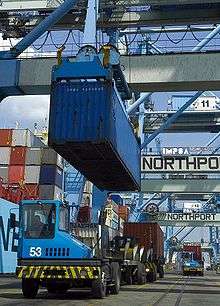Trade agreement
| Part of a series on |
| World trade |
|---|
 |
A trade agreement (also known as trade pact) is a wide ranging tax, tariff and trade treaty that often includes investment guarantees. The most common trade agreements are of the preferential and free trade types are concluded in order to reduce (or eliminate) tariffs, quotas and other trade restrictions on items traded between the signatories.
Classification of trade pacts
By number and type of signatories
A trade agreement is classified as bilateral (BTA) when signed between two sides, where each side could be a country (or other customs territory), a trade bloc or an informal group of countries (or other customs territories). A trade agreement signed between more than two sides (typically neighboring or in the same region) is classified as multilateral.
By level of integration
.png)
There are a variety of trade agreements; with some being quite complex (European Union), while others are less intensive (North American Free Trade Agreement).[1] The resulting level of economic integration depends on the specific type of trade pacts and policies adopted by the trade bloc:
- Separate
- Trade and Investment Framework Agreement (TIFA)
- Bilateral Investment Treaty (BIT)
- Preferential Trade Arrangement (PTA)–limited scope and depth of tariffs reduction between the customs territories.
- Free Trade Agreement establishing a Free Trade Area (FTA)–extensive reduction or elimination of tariffs on substantially all trade allowing for the free movement of goods and in more advanced agreements also reduction of restrictions on investment and establishment allowing for the free movement of capital and free movement of services
- Common market–FTA with significantly reduced or eliminated restrictions on the freedom of movement of all factors of production, including free movement of labour and of enterprise; and coordination in economic policy
- Free Trade Agreement establishing a Free Trade Area (FTA)–extensive reduction or elimination of tariffs on substantially all trade allowing for the free movement of goods and in more advanced agreements also reduction of restrictions on investment and establishment allowing for the free movement of capital and free movement of services
- Currency union–sharing the same currency
- Composite
- Customs union–FTA with common external tariffs of all signatories in respect to non-signatory countries
- Customs and monetary union–Customs union with Currency union
- Economic union–Customs union with Common market
- Economic and monetary union (EMU)–Economic union with Currency Union
- Fiscal Union–common coordination of substantial parts of the fiscal policies (proposed step between EMU and Complete economic integration)
- Economic and monetary union (EMU)–Economic union with Currency Union
- Customs union–FTA with common external tariffs of all signatories in respect to non-signatory countries
Special agreements
- World Trade Organization treaty
- agreements in the WTO framework (Textile Agreement and others)
- the now defunct Multilateral Agreement on Investment (in the OECD framework)
By the World Trade Organization
Typically the benefits and obligations of the trade agreements apply only to their signatories.
In the framework of the World Trade Organization, different agreement types are concluded (mostly during new member accessions), whose terms apply to all WTO members on the so-called most-favored basis (MFN), which means that beneficial terms agreed bilaterally with one trading partner will apply also to the rest of the WTO members.
All agreements concluded outside of the WTO framework (and granting additional benefits beyond the WTO MFN level, but applicable only between the signatories and not to the rest of the WTO members) are called preferential by the WTO. According to WTO rules these agreements are subject to certain requirements such as notification to the WTO and general reciprocity (the preferences should apply equally to each of the signatories of the agreement) where unilateral preferences (some of the signatories gain preferential access to the market of the other signatories, without lowering their own tariffs) are allowed only under exceptional circumstances and as temporary measure.[2]
The trade agreements called preferential by the WTO are also known as regional (RTA), despite not necessarily concluded by countries within a certain region. There are currently 205 agreements in force as of July 2007. Over 300 have been reported to the WTO.[3] The number of FTA has increased significantly over the last decade. Between 1948 and 1994, the General Agreement on Tariffs and Trade (GATT), the predecessor to the WTO, received 124 notifications. Since 1995 over 300 trade agreements have been enacted.[4]
The WTO is further classifying these agreements in the following types:
- Goods covering:
- basic preferential trade agreement (a.k.a. partial scope agreement)
- free trade agreement
- customs union
- Services covering:
- Economic Integration Agreement–any agreement, including a basic PTA, that covers also services
Reaction
Trade pacts are frequently politically contentious since they may change economic customs and deepen interdependence with trade partners. Increasing efficiency through "free trade" is a common goal. For the most part, governments are supportive of further trade agreements.
There have been however some concerns expressed by the WTO. According to Pascal Lamy, Director-General of the WTO, the proliferation of RTA “...is breeding concern — concern about incoherence, confusion, exponential increase of costs for business, unpredictability and even unfairness in trade relations.” [5] The position of the WTO is that while the typical trade agreements (called preferential or regional by the WTO) are useful to a degree, it is much more beneficial to focus on global agreements in the WTO framework such as the negotiations of the current Doha round.
The anti-globalization movement opposes such agreements almost by definition, but some groups normally allied within that movement, e.g. green parties, seek fair trade or safe trade provisions that moderate what they perceive to be the ill effects of globalization.
See also
Lists:
References
- ↑ Whalley, John (1998). "Why do countries seek Regional Trade Agreements". The Regionalization of the World Economy. p. 64. ISBN 0-226-25995-1. Retrieved 2008-07-21.
- ↑ The EU got a WTO waiver to grant favourable access to its market for the ACP states, without requiring that in return they open their markets to competition from the EU. The WTO waiver already expired and currently the EU and the ACP states are negotiating WTO compliant reciprocial agreements).
- ↑ "Regional trade agreements". WTO. July 2007. Retrieved 2008-07-20.
- ↑ "Facts and figures". World Trade Organization. Retrieved 2009-08-16.
- ↑ Lamy, Pascal (2007-09-10). "DG Pascal Lamy–Proliferation of regional trade agreements "breeding concern"". Geneva. Retrieved 2008-07-20.
External links
- ITC's Market Access Map, an online database of customs tariffs and market requirements.
Further reading
- Irwin, Douglas A. (2008). "International Trade Agreements". In David R. Henderson (ed.). Concise Encyclopedia of Economics (2nd ed.). Indianapolis: Library of Economics and Liberty. ISBN 978-0865976658. OCLC 237794267.
